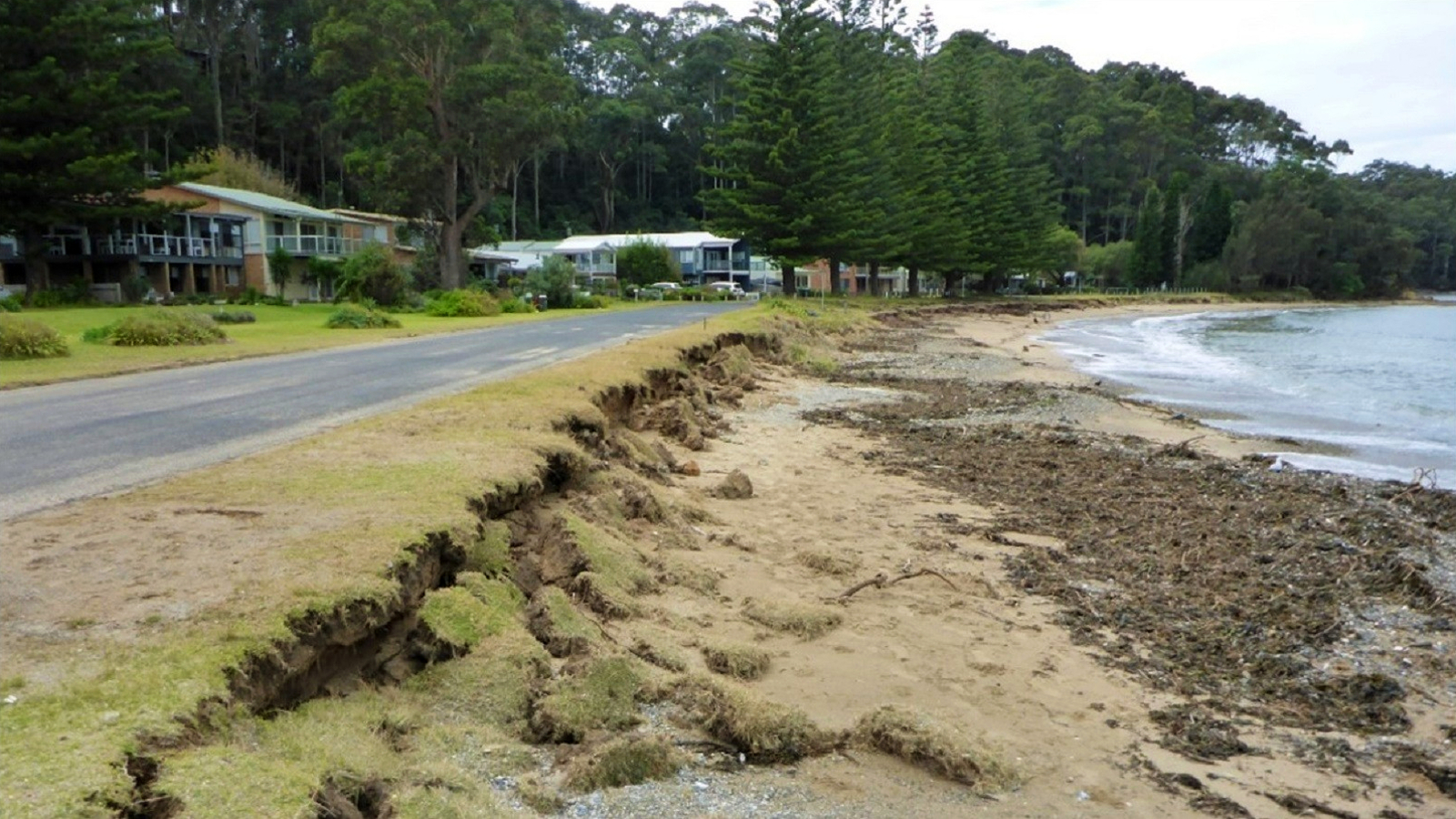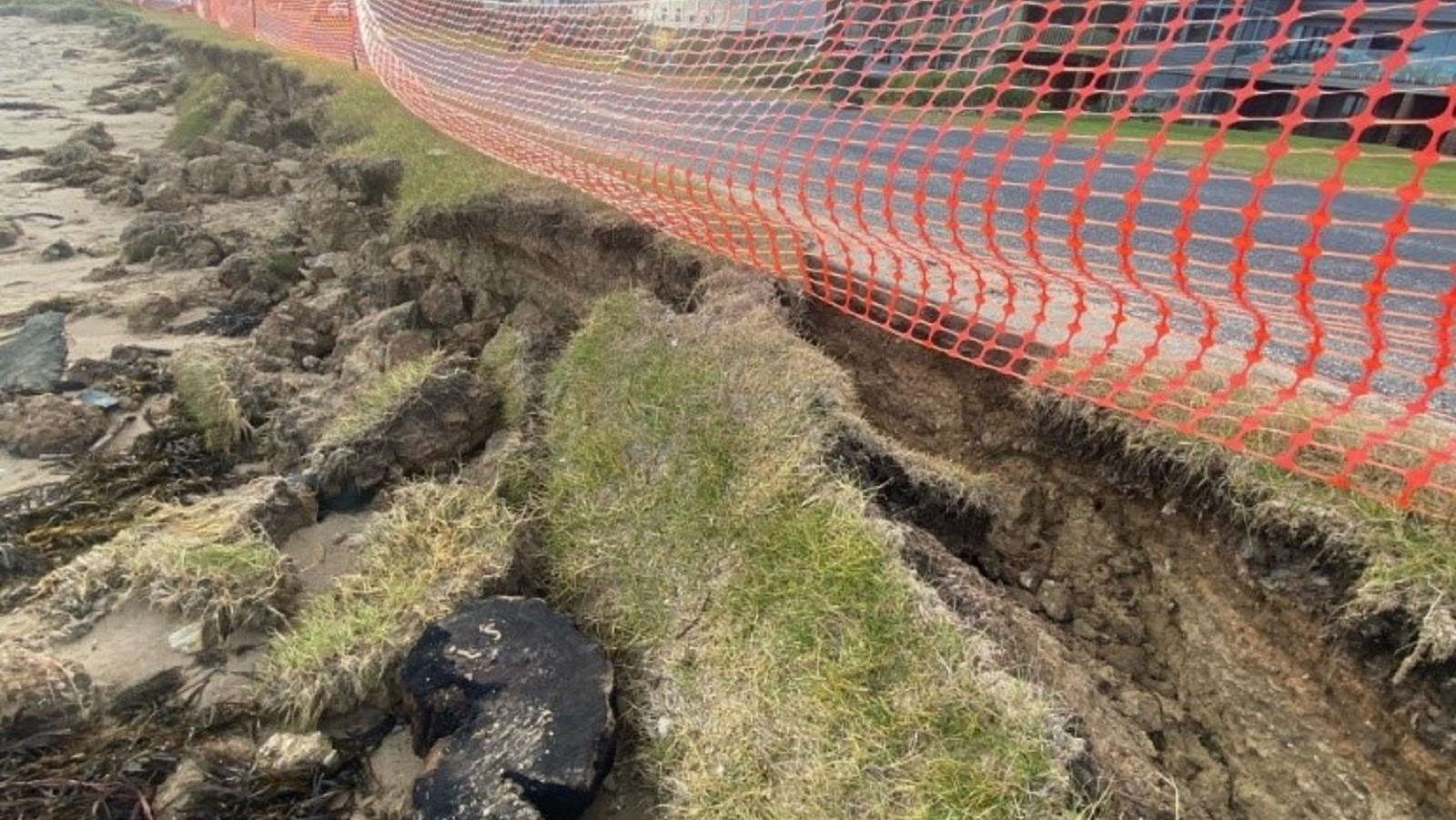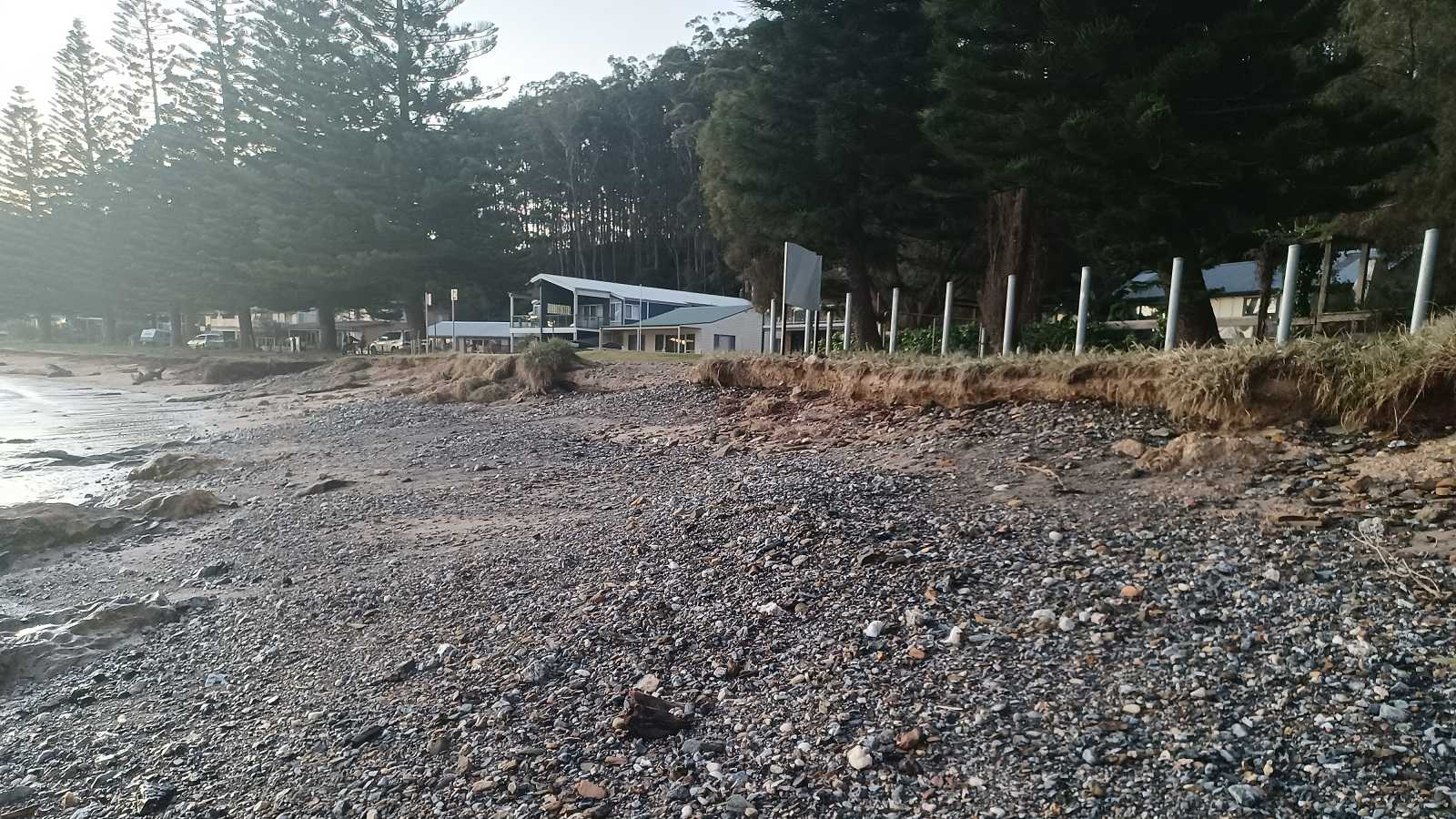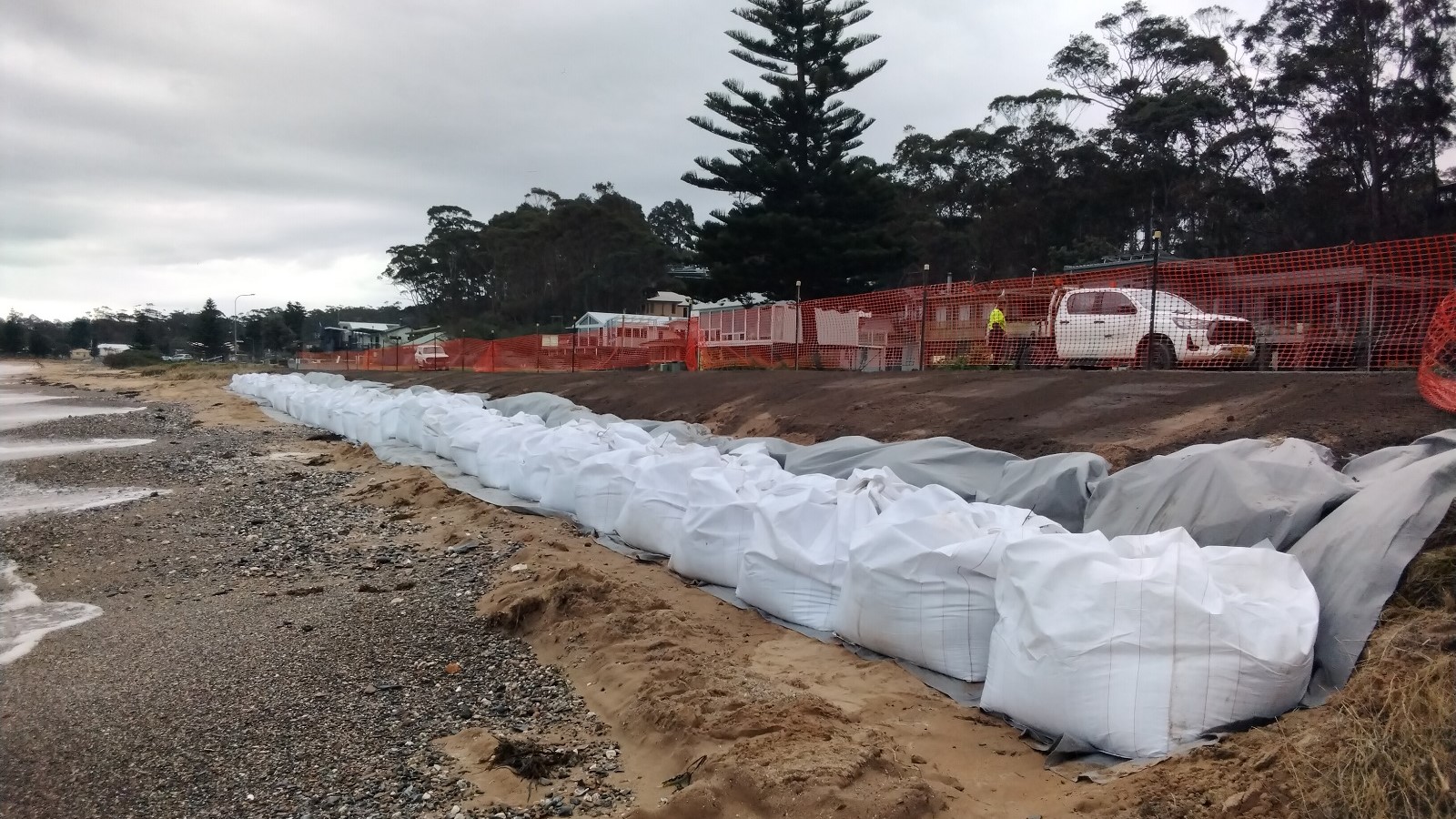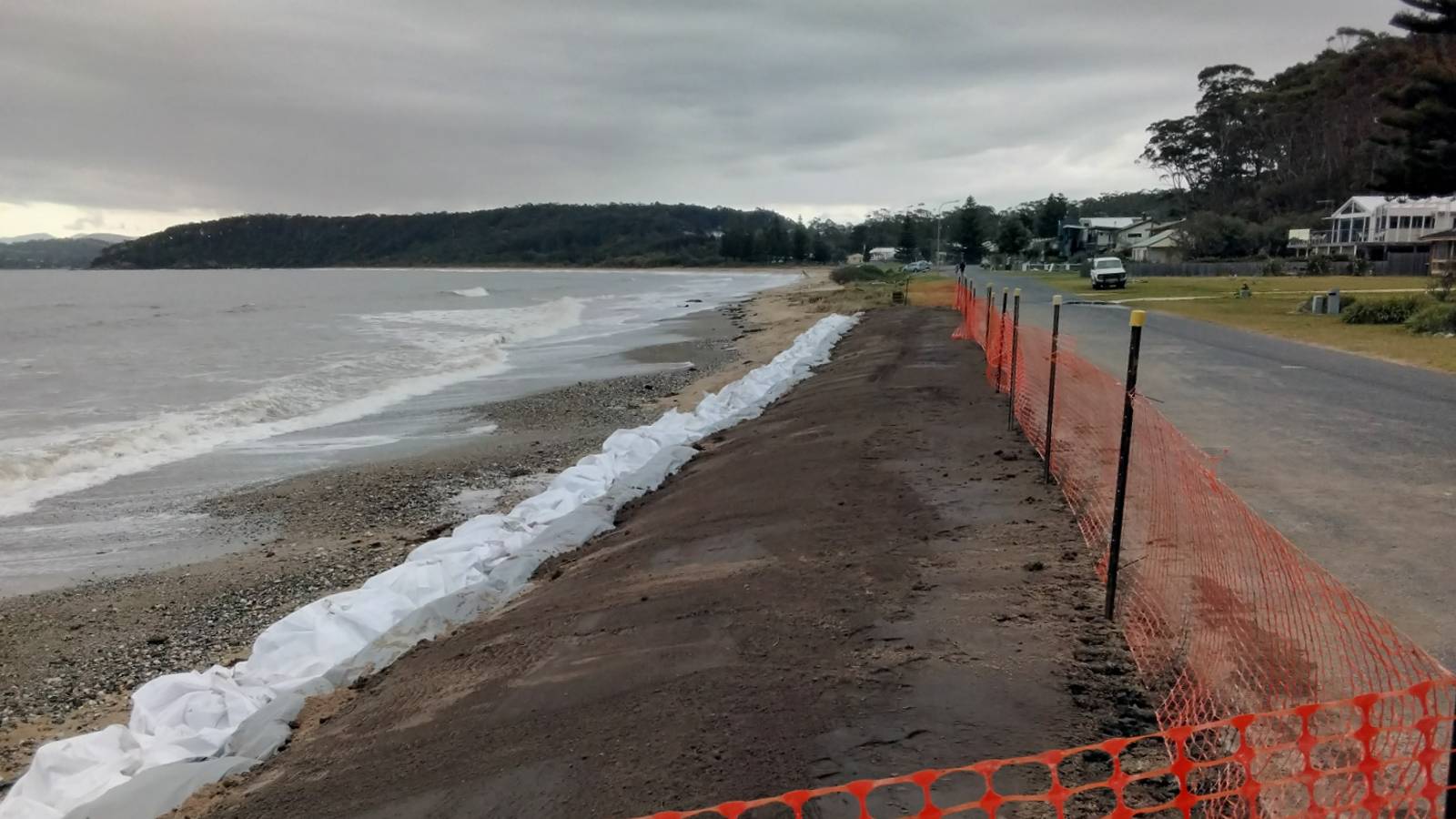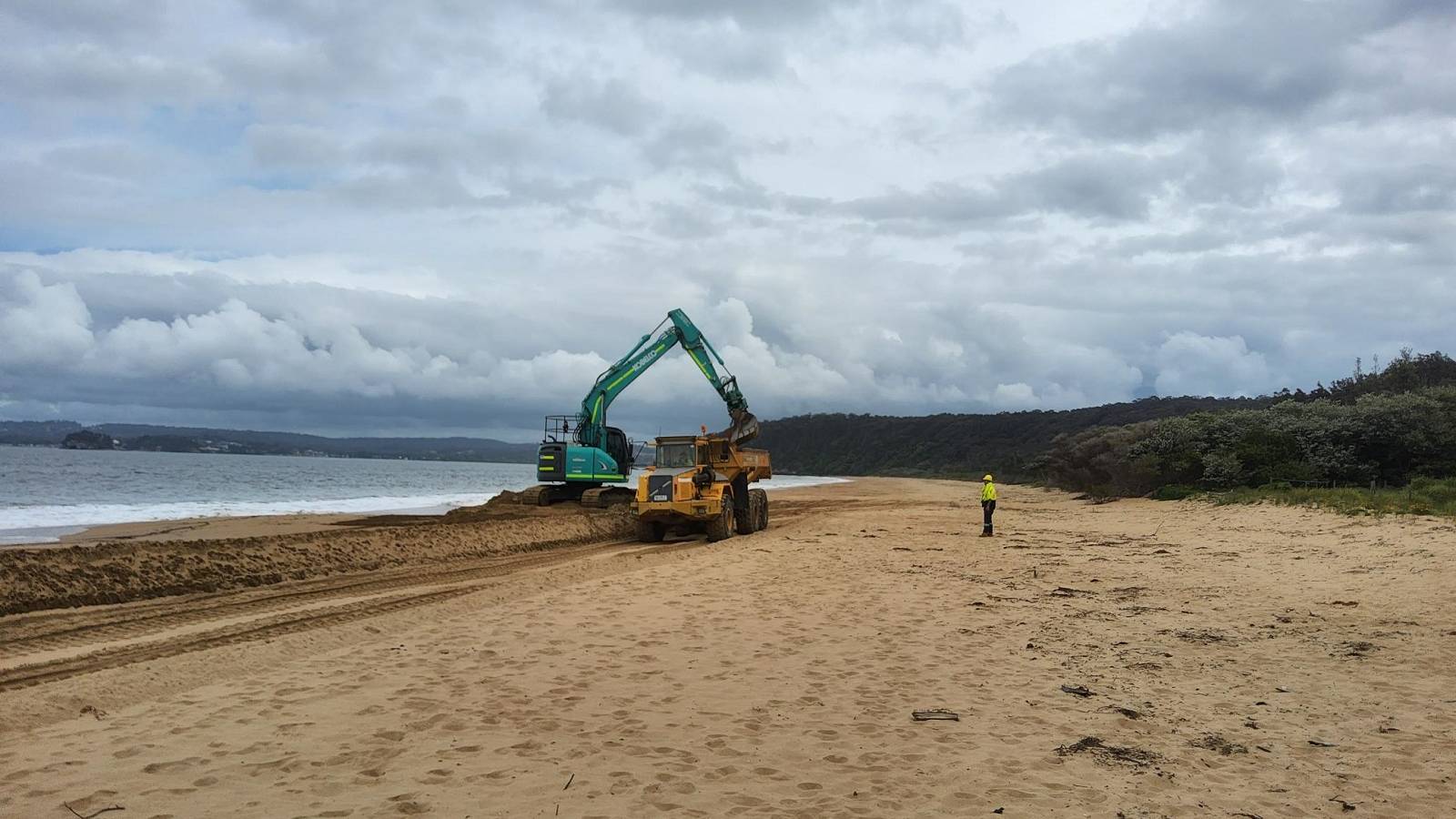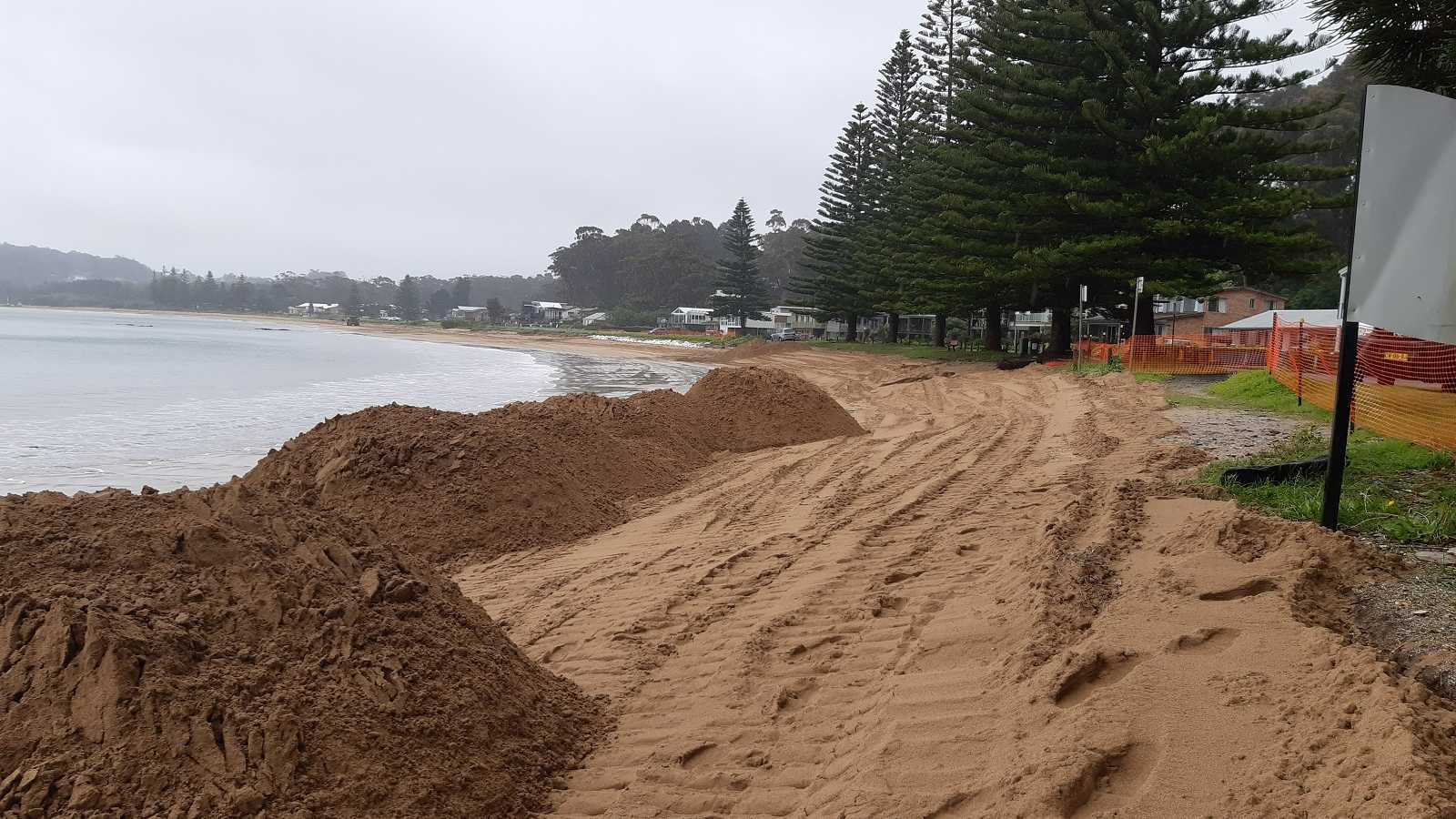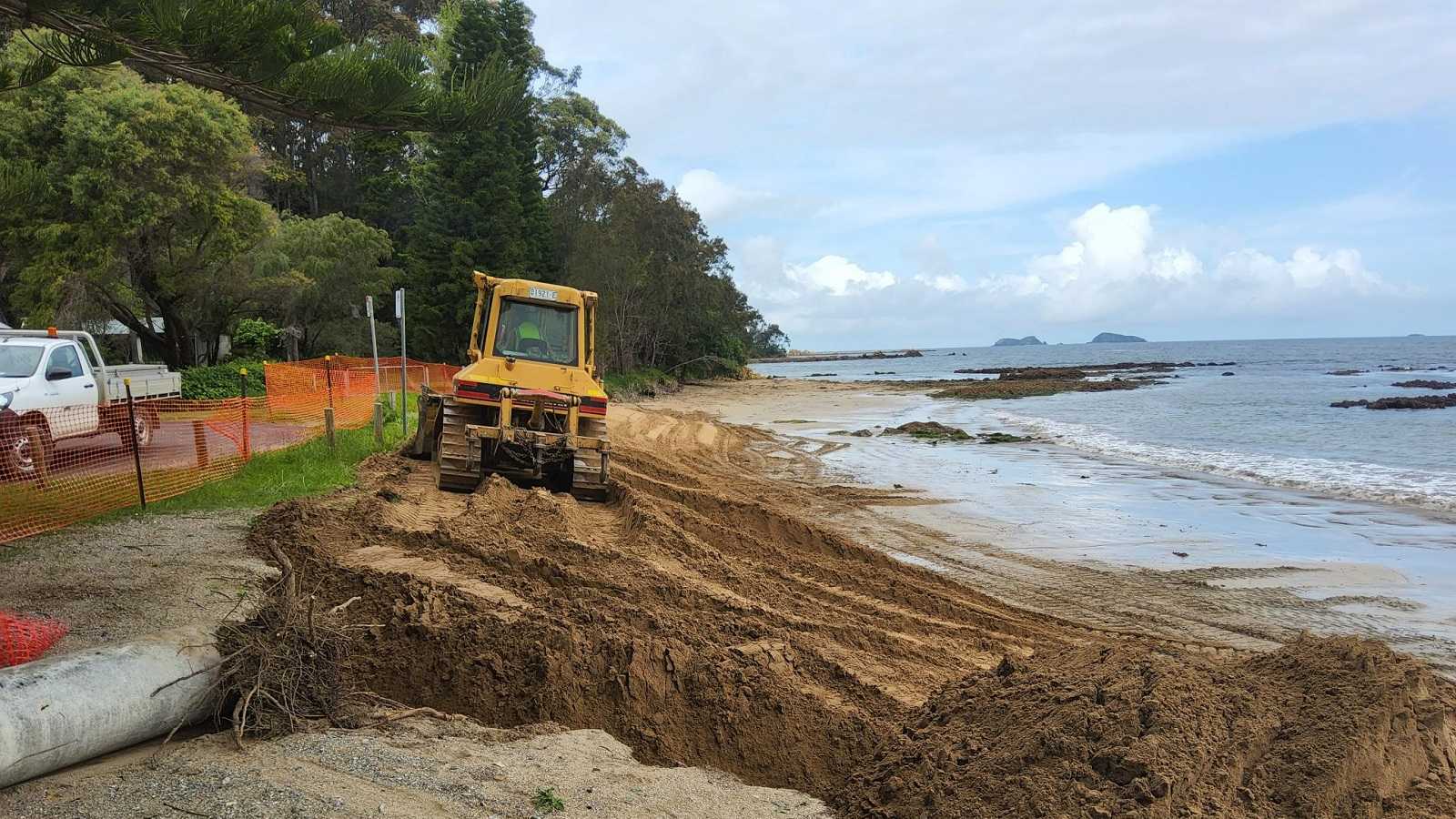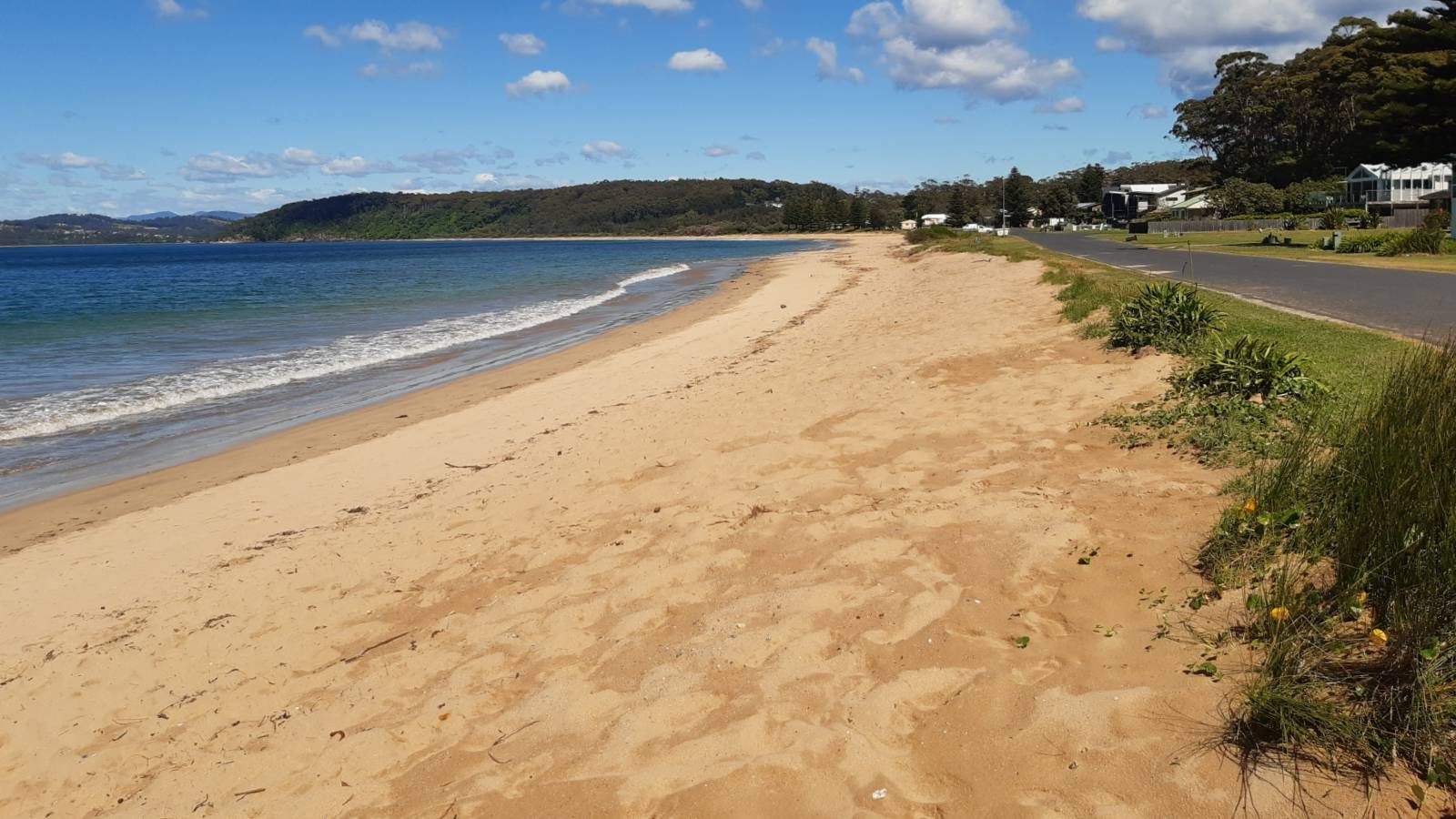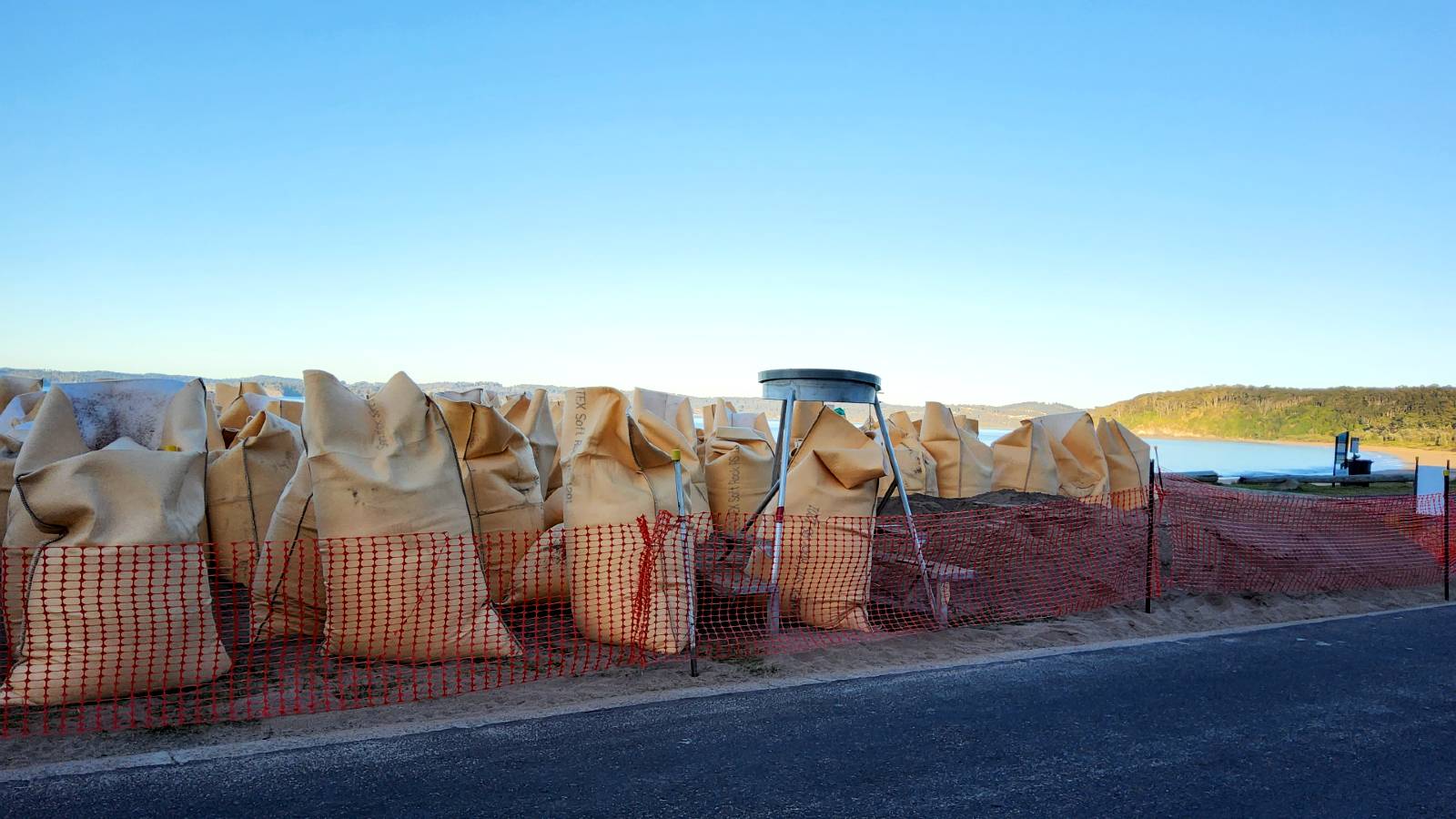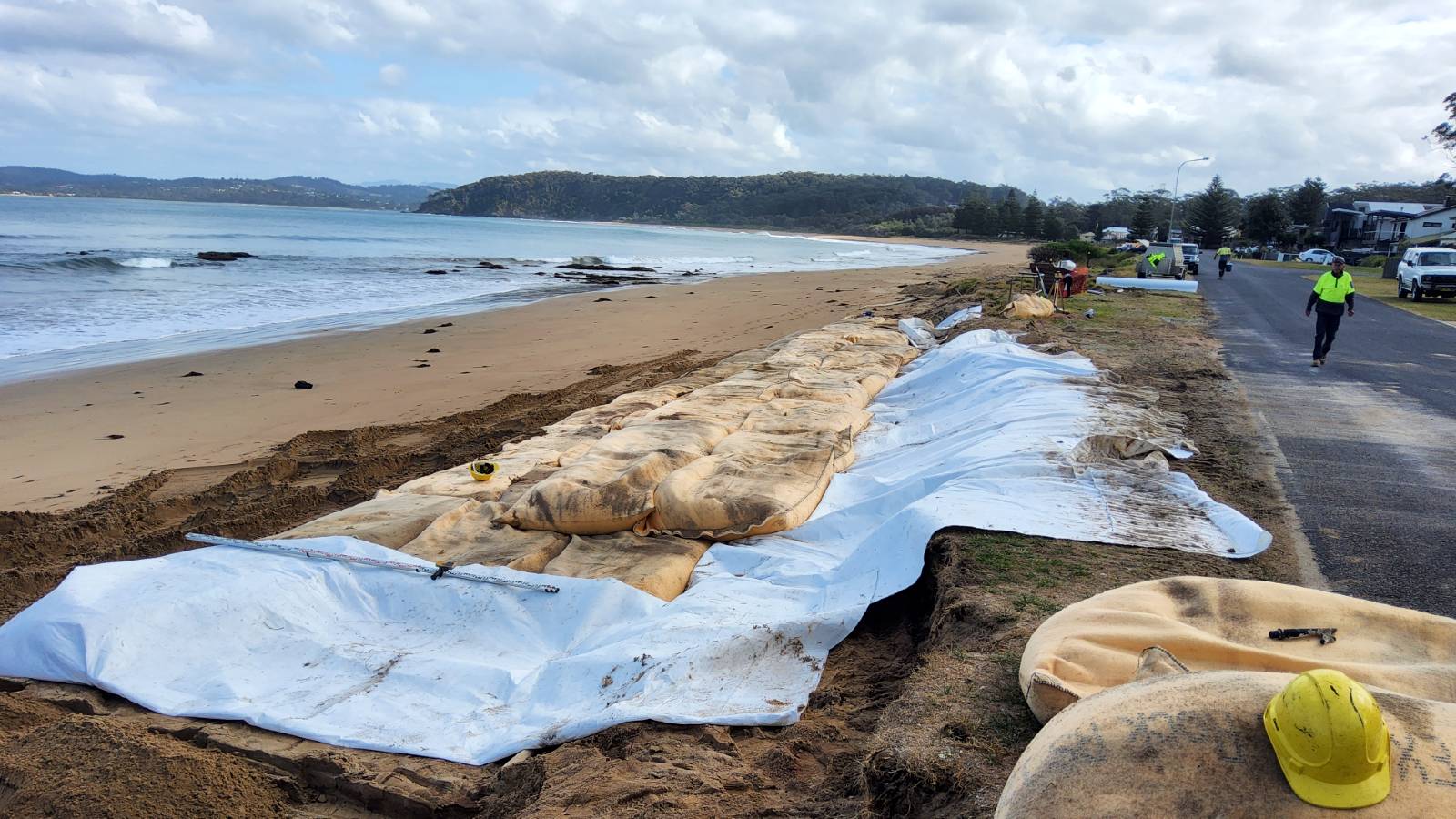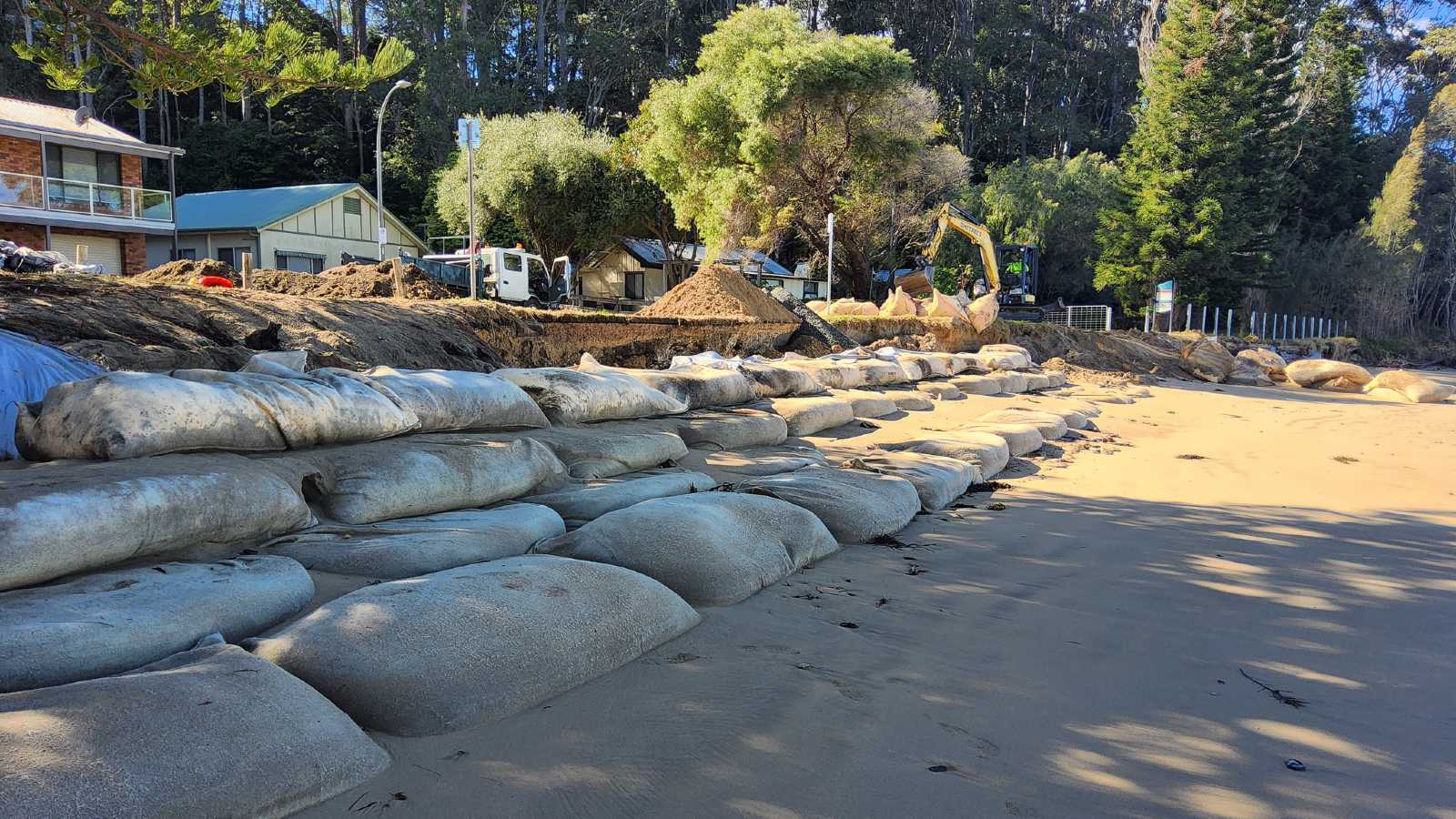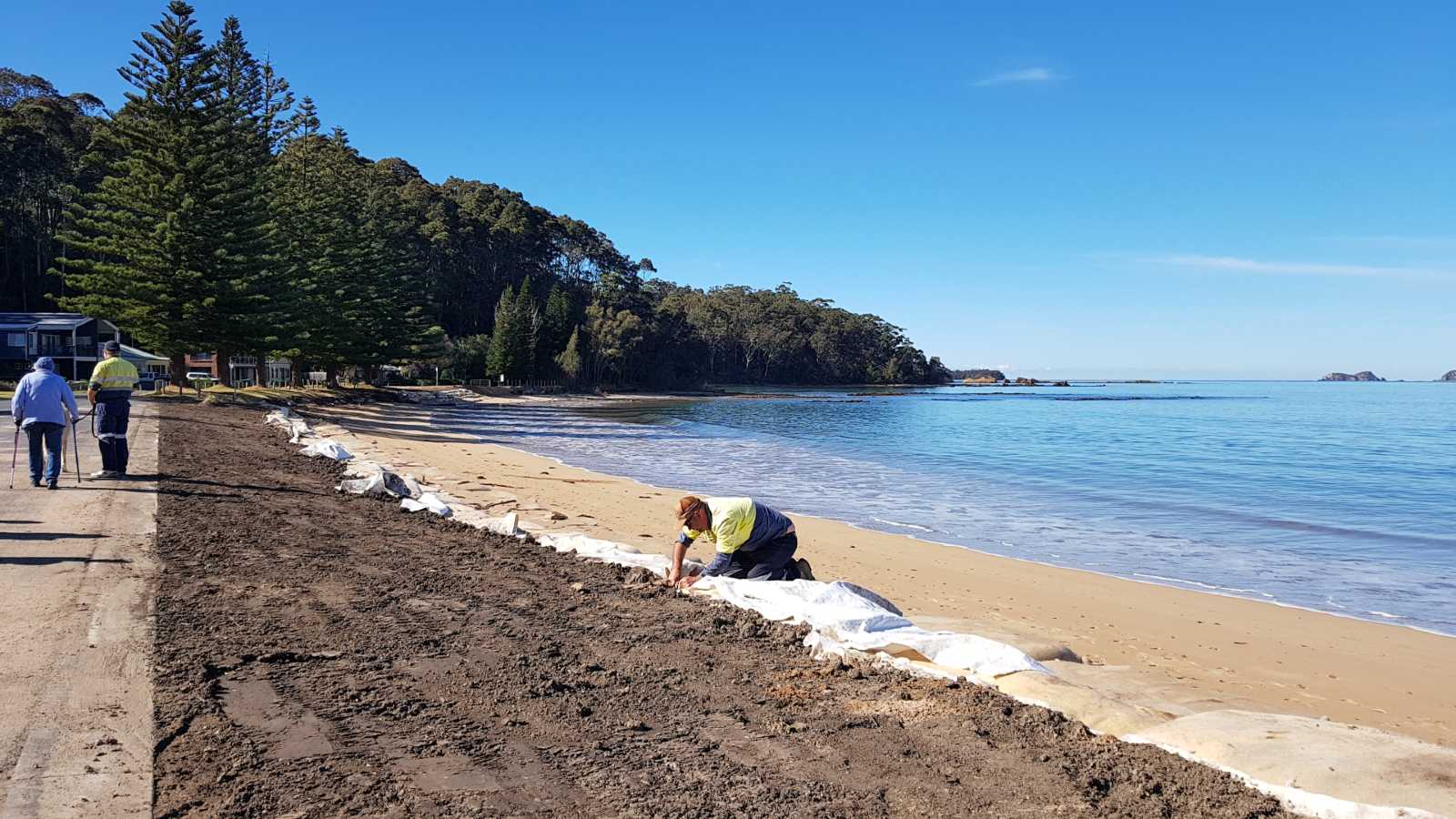Long Beach coastal erosion control
Project: Managing erosion of Long Beach and the impact on Bay Road
Timeframe: April 2022 until works are complete
Status: In progress
Cost and funding:
- Council funded the short-term emergency works.
- Council will seek funding for long-term solutions.
- The NSW Department of Climate Change, Energy, the Environment and Water is providing $5m to be shared between three coastal management projects.
Page last updated: December 2024
Project details
We are working to:
- reduce the likelihood of further erosion
- protect Bay Road from collapse
- keep the Norfolk Island pine trees.
Benefits to the community:
- access to the beach
- continued access to private properties
- maintained visual amenity.
Background
In April 2022, an east coast low caused significant erosion of the Long Beach coastline. A section of the beach and grassed area washed away right up to the road running alongside the beach. Bay Road became vulnerable and likely to collapse in future storms or high seas.
The road is critical for vehicles to access beachside properties. To protect the area, we began planning emergency works straight away. We had to apply for many approvals from various NSW Government agencies before work could begin. Obtaining permission to undertake short and medium-term emergency works was a complex process that took considerable time.
In May 2023 high seas caused more damage, exposing the edge of Bay Road cul-de-sac.
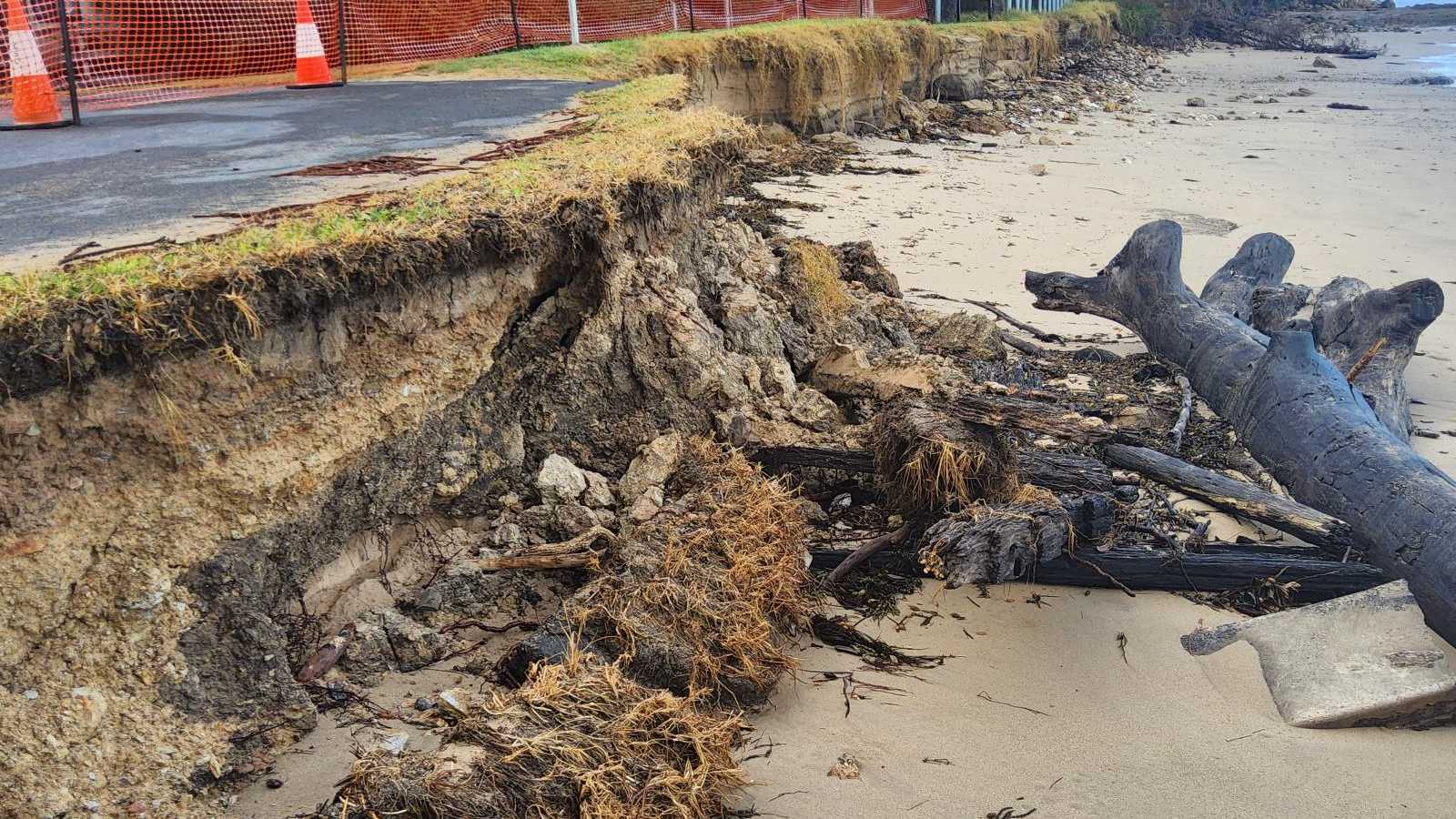
Short-term emergency works
- sandbagging
- beach nourishment, also called beach scraping.
To gain approval for the emergency works, we worked with various NSW Government agencies including:
- Crown Lands
- Department of Planning and Environment
- Batemans Marine Park Authority; and
- Department of Primary Industries – Fisheries.
The emergency works needed an environmental assessment, called a Review of Environmental Factors (REF) under Part 5 of the Environmental Planning and Assessment Act 1979. We prepared an REF to help reduce the likelihood of any unintended negative impacts.
Sandbagging
In July 2022, after acquiring necessary approvals, we placed sandbags along the beach in the affected area. The large sandbags were filled with imported sand of a compatible nature. Butted up together, they act as a buffer against immediate wave impact to the road.
The sandbags were a temporary measure and NSW legislation only allowed them to remain in place for 90 days.
Beach nourishment
In September 2022, we acquired necessary approvals to undertake beach nourishment works. This process involves taking sand from one location and placing it in the impacted area. In October we used heavy machinery to scrape a 300mm layer of sand from the southern end of Long Beach and push it against the eroded area.
The Department of Planning and Environment has advised that the method of sourcing sand over a large, shallow area is consistent with the approach taken by neighbouring councils. The southern end of the beach is replenishing through the natural sand movement associated with longshore drift.
The sand is providing a berm and is acting as a buffer while we look at long-term solutions.
Norfolk Island pine trees
The roots of large Norfolk Island pine trees on Bay Road were exposed by beach erosion. Council’s arborist assessed the trees and found them to be in good health. The root exposure did not represent a significant risk to tree health or to stability.
We provided protection against further erosion around the trees by covering the exposed roots with sand sourced from the southern end of the beach. Our arborist will reinspect the trees if any changes become apparent.
Medium-term solution
After the further damage caused in May 2023, we received approval to undertake more substantial work to protect Bay Road. We used specialised equipment to fill large sandbags made from geotextile fabric. Unlike the open bulker bags used as a temporary measure, these new sandbags are fully enclosed and weigh 2 tonnes each.
We strategically placed these sandbags in the most affected areas. These geotextile sandbags will significantly reduce the likelihood and severity of future erosion and shore up Bay Road against potential collapse. Similar sandbags have proven effective in other coastal areas of NSW.
Pending approvals, the geotextile sandbags will remain in place until a long-term solution is designed and implemented.
Long-term solutions
We are now working on designs for a more permanent structure to stabilise the shoreline. NSW legislation does not allow such works to be undertaken as emergency works and we can only implement them through a certified Coastal Management Program.
In 2022 Council adopted the Eurobodalla Open Coast Coastal Management Program (CMP). The CMP examines the impacts of coastal hazards and is our guide for managing these hazards. It is a plan of action, setting the long-term strategy for the coordinated management of land in coastal areas. Protecting Bay Road is identified as a priority in the CMP and it identifies a structure such as a low-lying revetment as a long-term solution.
The CMP was certified by the NSW Minister for Local Government in 2023, allowing us to focus on long-term works and secure funding. The CMP also includes emergency management plans to help us better manage similar future erosion events.
We have heard from the community that the main priority for a management outcome is one that:
- does not disrupt access to the foreshore. The solution must ensure the beach remains accessible for all members of the community, including those with limited mobility and those who use watercraft such as kayaks
- maintains the natural character of the foreshore. Long Beach residents and visitors value the open, unobstructed nature of the beach. Hard structures and vegetation must be low lying to maintain this character
- does not compromise the amenity of the beach. Any hard solution will take up space on the beach. The right solution must protect this beach amenity as well as the road behind the beach.
In June 2024 our consultant prepared designs for three potential long-term solutions and we invited the community to learn about them and provide feedback. Our consultant then compared the options, considering community feedback and social, environmental, and economic factors to determine the most feasible, viable, and acceptable option. The sloped rock revetment scored the highest in their assessment, so we're going with it as the best choice. The community liked the sloped rock revetment because it is cost-effective, long-lasting, looks better than the sandbags or concrete wall options. Additionally, this option should not harm the Norfolk pines and can be softened with vegetation and other landscaping options.
Large boulders will create a sloped embankment, mostly buried under the beach with only the top section visible above the sand. It can be buried and revegetated to look like a natural dune. It is moderately priced, with a lifespan of up to 50 years. It can be installed without harming the roots of Norfolk Island pines and is easier to build than a vertical seawall. It is more adaptable to future sea-level rise and can absorb wave energy, reducing wave reflections and minimising damage.
The structure would likely extend about 1m above the beach, rising to the level of the land behind it. It would be set deep below ground to provide strong foundations and prevent undermining during storms. If high seas or extreme weather events wash away the beach, the lower parts of the structure may become exposed until the sand returns to the foreshore.
The consultant will now create a detailed design for the rock revetment, incorporating community feedback to ensure it looks good and blends into the local landscape. We'll share the design with the community once it is ready.
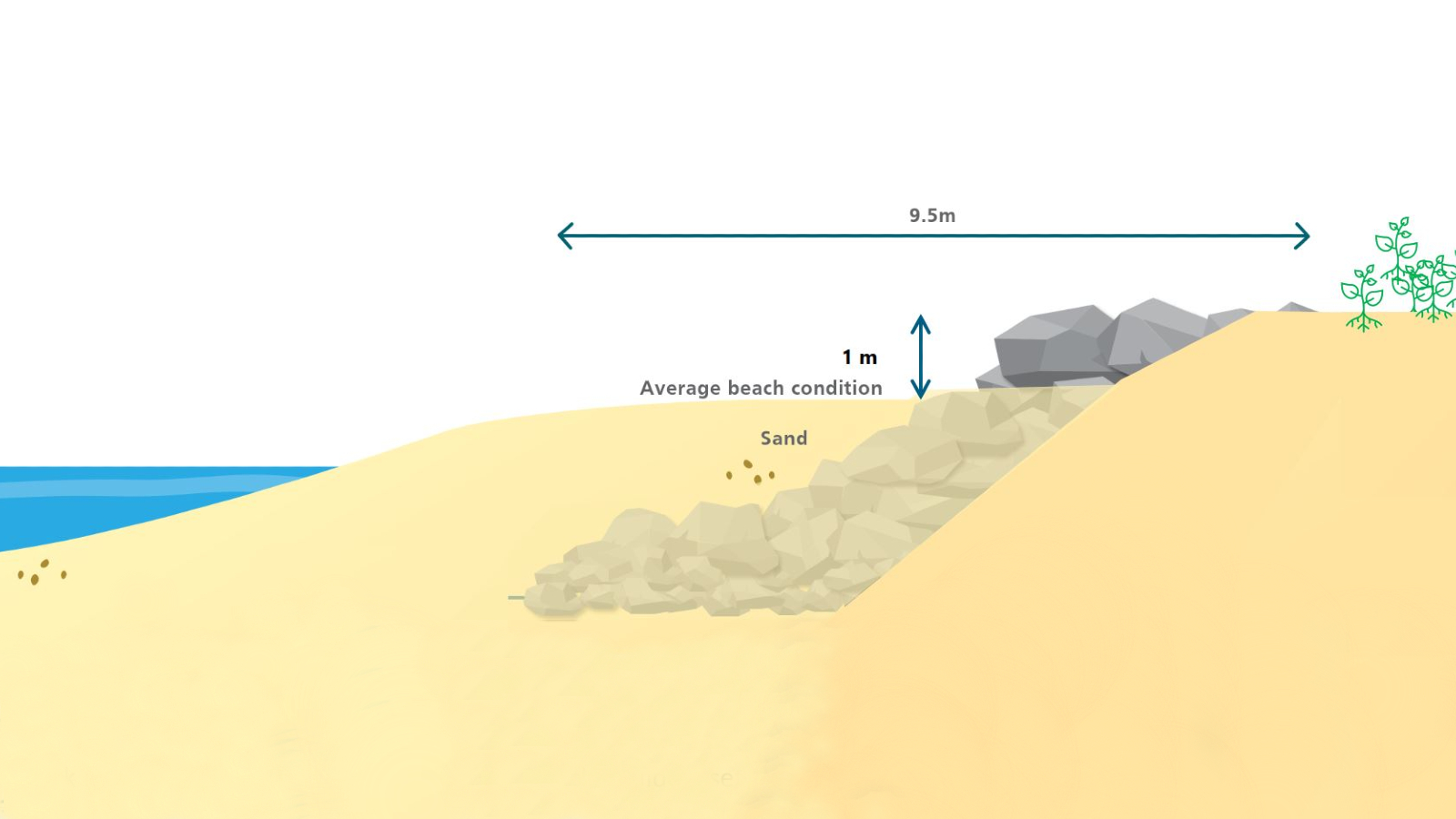
To find out about work planned through the CMP and to follow progress for the permanent work at Long Beach, visit:
Project updates
August 2024
- Our consultant compared the options to help us work out the best way to provide long-term coastal protection for Long Beach. They considered community feedback and social, environmental, and economic factors to determine the most feasible, viable, and acceptable option. The sloped rock revetment scored the highest in their assessment, so we're going with it as the best choice. The community liked the sloped rock revetment because it is cost-effective, long-lasting, looks better than the sandbags or concrete wall options. Additionally, this option should not harm the Norfolk pines and can be softened with vegetation and other landscaping options.
- The consultant will now create a detailed design for the rock revetment, incorporating community feedback to ensure it looks good and blends into the local landscape. We'll share the design with the community once it is ready.
July 2024
- We returned to Bay Road for some urgent work on the sandbag structure that’s in place to protect the shoreline. Work includes extending the structure to the south and repositioning sandbags that have moved out of place.
- We received some fantastic input from the Long Beach community about how we can best manage coastal erosion in the long term.
- Our team started working with the consultant to review all the feedback and find the most suitable solution.
June 2024
- Worley Consulting developed three potential long-term solutions for managing the coastal erosion at Bay Road.
- We invited the community to a drop-in session at the Long Beach RFS shed from 4-6pm on 18 June to find out about each of the options and to provide feedback.
March 2024
- We awarded the tender for designing the Batemans Bay Coastal Erosion Protection Works to Worley Consulting. The design includes developing measures to protect the eastern end of Bay Road from severe coastal storm events.
August 2023
- We completed the geo-textile sandbag structure along the worst affected areas of Long Beach. Wrangling sandbags that weighed a whooping 2 tonnes each was no small feat. Stitching, lifting and positioning each bag took creativity, skill, and a lot of patience.
July 2023
- We started filling the giant geotextile sandbags and placing them along the foreshore.
June 2023
- We acquired the specialised equipment and materials needed to create a geotextile sandbag structure to protect Bay Road and the foreshore.
- The sandbag structure will serve as a medium-term solution while we investigate long-term options.
May 2023
- A huge swell eroded Long Beach exposing the edge of Bay Road again.
- We gained approval from the relevant NSW Government agencies to install geotextile bags to protect the road.
March 2023
- The NSW Department of Planning and Environment has committed to providing $5M for three actions identified in the CMP. One of these actions is the protection of Bay Road, Long Beach from beach erosion.
- We are now liaising with NSW Public Works to project manage the coastal protection works.
February 2023
- The CMP has been certified by the NSW Minister for Local Government.
December 2022
- Council adopted the Eurobodalla Open Coast CMP at the Ordinary Council Meeting on 13 December. We then submitted it to the NSW Minister for Local Government for certification.
- The beach nourishment work has been successful with the sand staying in place, protecting the road and Norfolk pines. The southern end of the beach is replenishing naturally after we sourced the sand from the far end.
November 2022
- We hosted a drop-in session at the Long Beach RFS on 3 November. Council staff and consultants were available to answer questions and discuss coastal management solutions with the community.
October 2022
- We started on the beach nourishment works using dump trucks and heavy plant to replenish the sand in the eroded areas. This was emergency work and was approved by relevant NSW Government agencies.
- We placed the draft Open Coast Coastal Management Program on public exhibition for community feedback from Wednesday 12 October to Wednesday 23 November 2022.
September 2022
- We received further approvals to undertake beach nourishment works and place sandbags along the Bay Road cul-de-sac
- High seas washed away sand from around the base of the large Norfolk Island pines exposing the trees’ roots.
- Our arborist undertook assessments of the trees.
August 2022
- High seas caused erosion to the beach next to the Bay Road cul-de-sac.
- We received the first approval to undertake beach nourishment works.
July 2022
- We placed large sandbags along the affected area to protect Bay Road from further erosion.
June 2022
- We met with various NSW agencies on-site to reach an agreement on permission to undertake emergency works
- We redirected resources so we could prepare:
- a Review of Environmental Factors (REFs)
- various approval applications to undertake emergency works.
April 2022
- An east coast low weather event caused significant erosion of the Long Beach shoreline.
- The sea washed away sand right up to Bay Road, creating concern about the future of the bitumen road.
Community engagement
We liaised with the community at key stages while preparing the Open Coast Coastal Management Program (CMP). Working with the Long Beach Community Association and other residents, we considered the possible solutions for erosion management.
- The community had an opportunity to give feedback while the draft Open Coast CMP was on public exhibition. The draft was available on our public exhibition web page until 23 November 2022.
- We also hosted a drop-in session on 3 November 2022 for residents to talk with Council staff and consultants about the draft Open Coast CMP and actions for the Long Beach area.
Sign up for project updates
Contact us
For more information, please contact us:
- T: 02 4474 1000
- E: Council

